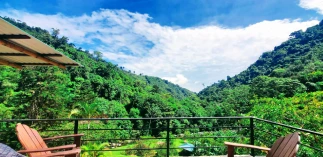Here at our mountain retreat, nestled amidst the emerald embrace of Costa Rican rainforests, every day brings a new chorus of birdsong. Today, we turn our spotlight to a tiny tenant of the highlands, the Gray-breasted Wood-Wren (Henicorhina leucophrys).
A Speckled Sprite
This little wonder is a true charmer, a ball of rufous feathers barely reaching 4.5 inches long. Its crown boasts a crown of dull black feathers with a hint of brown at the tips, while its back transitions from a deep olive brown on the nape and shoulders to a rich chestnut on the lower back, rump, and tail. Keep an eye out for the black bars that adorn the tail, adding a touch of elegance to this miniature marvel.
A Striking Face
But the Gray-breasted Wood-Wren’s true showstopper is its face. A long, grayish-white stripe runs above its eye, a bold contrast to the wide black stripe that stretches behind it. Its cheeks, a captivating blend of black and pale gray streaks, frame its pale gray chin and throat. The chest, as the name suggests, is a beautiful shade of gray, deepening towards the belly. The sides and lower flanks boast a delightful dark buff color, completing this little bird’s exquisite plumage.
A Voice Like a Melodic Rollercoaster
While the Gray-breasted Wood-Wren might be shy and elusive, flitting about the dense undergrowth of humid montane forests, its voice is anything but subtle. Its most recognizable call is a loud, scolding rattle, a sound that belies its diminutive size. But listen closely, and you might be rewarded with a rich, whistled song, a melody with a playful, rollicking cadence that sets it apart from other wren songs in the forest.
A Highland Hideaway
Finding the Gray-breasted Wood-Wren requires venturing beyond the central valley region. These little sprites prefer the cool embrace of the mountains, typically residing at elevations above 1,500 meters. Our mountain retreat, nestled amidst these verdant highlands, provides the perfect opportunity to spot this delightful denizen of the forest.
Tips for Observing the Gray-Breasted Wood-Wren
- Early Bird Gets the Wren: Patience is key. Head out for a nature walk in the early morning hours, when these little songsters are most active.
- Listen Up: The Gray-breasted Wood-Wren might be small, but its voice carries. Train your ears for its distinctive calls and whistles.
- Forest Focus: Focus your gaze on the dense understory, particularly areas with thick brush piles or flower banks, where these little birds love to forage.
- Silent Stalking: Move slowly and quietly through the forest to avoid startling these shy creatures.
With a little patience and these handy tips, you might just catch a glimpse of the Gray-breasted Wood-Wren, a tiny ball of charm with a captivating song, adding another delightful verse to the symphony of the Costa Rican rainforest. Keep an eye out on our next blog post, where we’ll delve into the life of another feathered resident of this extraordinary country.
For more information, please view our comprehensive guide about the birds of Costa Rica







